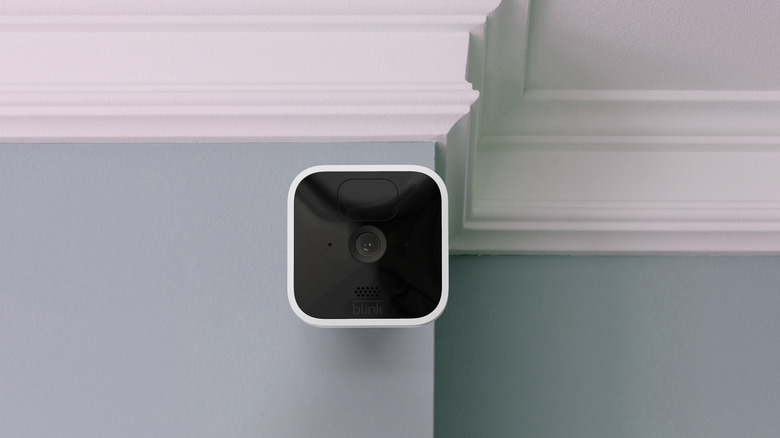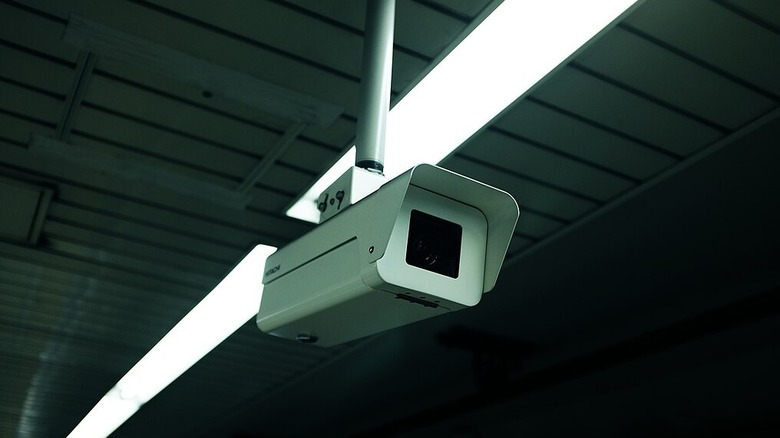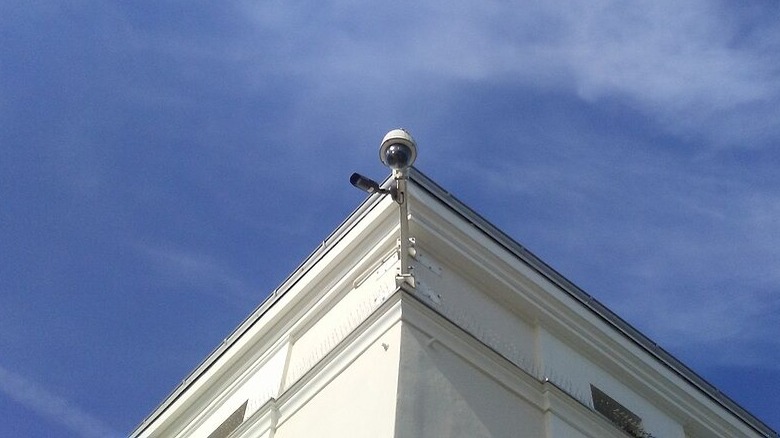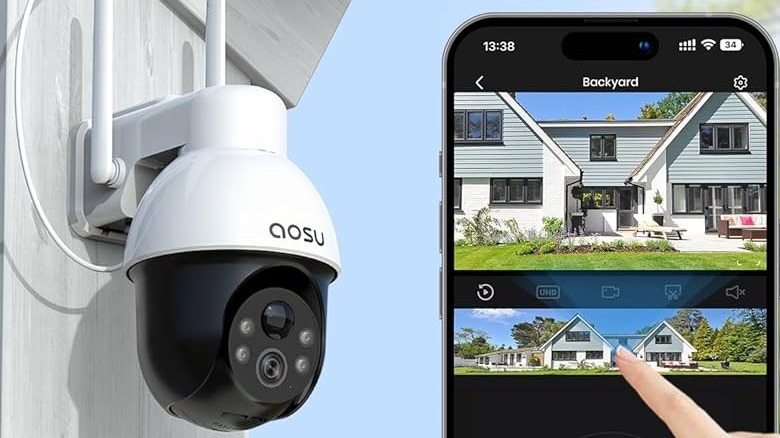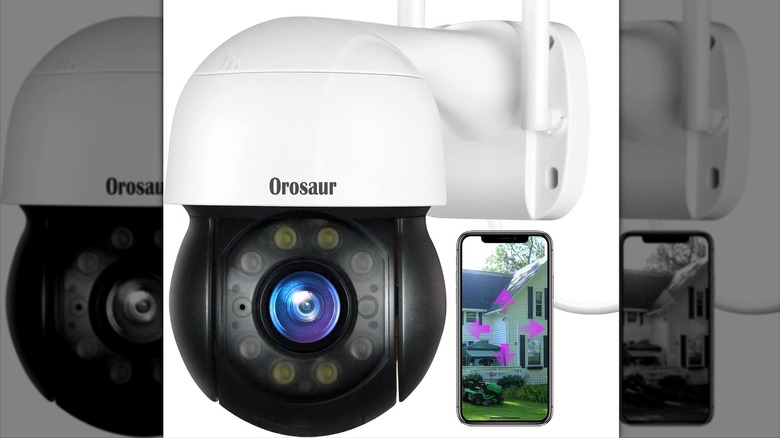11 Mistakes You Might Be Making When Installing Security Cameras In Your Home
We may receive a commission on purchases made from links.
When it comes to buying security cameras for your home, there is a lot to consider. How big is your home, how many cameras do you need, is your Wi-Fi strong enough for multiple cameras, and just how much is it all going to cost?
There's also the question of whether to hire a professional to install your cameras or to take the DIY route. While 44% of consumers hire a pro, according to Consumer Affairs, most people go it alone. That's not necessarily a bad thing, especially if it saves you money.
However, research turns out to be the most important step to avoid making some common security camera installation mistakes. From the small print in the product description to the laws that apply to your neighborhood and property, things can go sideways if you click "add to cart" without thinking ahead.
Home security cameras are more affordable and ubiquitous than ever, with around 10.8 million U.S. households employing a DIY security system. Still, they're not always simple, even though the drop in burglary incidents since 2011 may have something to do with the rise in residential security camera usage.
Choosing between Ring and Blink is an important decision, but it's not the only consideration while planning for home security cameras. You might be making one of these common mistakes — or multiple — during installation.
Assuming cameras are legal protection
One of the main reasons many people buy security cameras is to deter potential crime. For homeowners, the motivation could be anything from high local crime rates to a history of holiday package thefts in the neighborhood.
The few statistics you can find on home security cameras seem to suggest that cameras do help prevent burglaries and other crimes. Some professionals in the security camera industry propose that homes equipped with security cameras are 300% less likely to be burglarized than homes without them.
xRiver Run Law points out that camera footage has to be relevant, authenticated, and not violate privacy laws to be admissible in court. State laws vary on security camera recordings, and privacy regulations also come into play. For example, in Georgia, surveillance cameras are allowed in public spaces if they're in plain sight, while in Hawaii, consent is required to film people.
California law specifies that confidential communications cannot be filmed, and the presence of such communications in crime footage can complicate legal matters. While cameras can add a layer of security to your home, it's not ideal to rely on them entirely for peace of mind or legal action. Thus, you still need to lock your doors, keep an eye out for suspicious behavior, stow away valuables, and ensure compliance with state laws on the admissibility of camera footage in court.
Presuming you can have hidden cameras
Plenty of people use security cameras inside their homes for everything from monitoring pets while they're away to checking on kids when the babysitter is over. Even inside your own home, however, there are laws governing the use of security cameras. The same laws that apply to cameras outside often extend to inside the house as well.
For example, security cameras are generally legal in common areas like your living room, where there's no reasonable expectation of privacy as there would be in a bathroom or even inside a closet. Recording audio can also become a legal issue, especially if you live in a state where all parties must consent to being recorded.
Even if you're not using audio and video recordings for legal purposes, having that footage could create liability if it's shared publicly. In California, for example, each person featured in an audio recording must consent. In Arkansas, however, only one person involved in the communication (e.g., the person recording) must consent for the recording to be legal.
Hidden cameras are also subject to different rules than ones you can easily spot, whether they record audio or both audio and video. Even if you suspect someone of a crime inside your home, placing a hidden camera in their bedroom is likely illegal. On a similar note, you also can't have a camera pointing into your neighbor's private areas — more on that later.
Installing cameras in public places
For most people who own property, there aren't too many limits on where and how you can use your security cameras. For example, laws govern the use of public spaces, but privacy is not part of the use of a public space. The general lack of expectation of privacy is the reason why people are allowed to film (for social media or any other reason) in places like parks and on public transportation with no repercussions — or consent forms from their subjects.
Still, if you rent a home or live in a community with a Homeowners Association (HOA), there might be shared spaces where cameras aren't allowed. HOAs often have their own governing documents that include specific rules, which you'll need to follow even if they don't apply elsewhere.
Plus, while it's usually legal to position cameras facing the street, over sidewalks, or even looking over your fence, that doesn't mean it won't upset the neighbors. Other rules also apply when you share space with other people. If you have roommates, for example, it's prudent to let them know where you plan to install the cameras and what they can see.
Even if you live alone on a ton of property, it's smart to check your local regulations on where cameras can be placed and what they can monitor.
[Featured image by Alex Knight via Wikimedia Commons | Cropped and scaled | CC BY-SA 3.0]
Pointing cameras off your property
Overlooking a neighbor's property is one of the worst places to install a security camera. It's a bad idea not just because of the potential for conflict with your neighbors but also because it could escalate tensions if you're already having problems with them. Additionally, pointing cameras off your property can be illegal, especially if you have a clear view of private areas.
Even if your cameras aren't aimed into your neighbor's windows (which is definitely illegal in California, for example), you still need to be careful about what you're recording. Cameras that point into your neighbor's backyard are also a legal no-no because that's your neighbor's private space. The same laws that make it okay to record inside your home or your backyard also make it illegal to do so in your neighbors' private spaces.
You can also get in trouble if you live in a highly commercial area. Cameras that are perceived as monitoring nearby businesses could cause issues, even if you're putting them up to address criminal activity. The potential for retaliation is also very real, unfortunately, which is something many people don't think of when installing security cameras.
[Featured image by WrS.tm.pl via Wikimedia Commons | Cropped and scaled | CC BY-SA 3.0]
Not considering backup power
Depending on what type of security camera system you buy, backup power might be an important consideration. One of the biggest mistakes involved with security camera installation is not thinking about how you'll maintain power to your system.
Wired cameras may be the most convenient most of the time, as they stay powered when your home has electricity. However, installing the wiring can be a challenge for many homeowners. Plus, if your power goes out, so do your cameras.
Battery-powered cameras are another option, which is what I have at my house. We do go through a lot of batteries in our motion-detecting Blink cameras, but likely not as many as we would with continuously recording cameras. One complicating factor with battery-powered cameras, however, is that they may require a bridge to connect to your Wi-Fi.
Blink cameras use a sync module (their term for a bridge) as a receiver for all the cameras, and the receiver then "talks" to your app over the Wi-Fi. When our power goes out, so does the sync module that's plugged in inside the house, so backup power comes into play again.
Solar-powered security cameras can solve some of these issues — albeit not always the sync module one — and only rely on a few hours of sunlight to charge up. Most solar-powered cameras also remain plugged in all the time, so there's almost constant charging happening. Even if your cameras continuously record, this might be an energy-efficient way to keep them running.
Not reading the fine print
Reading the fine print is a must with any major purchase, and even if they're inexpensive, home security cameras are definitely a major purchase. There are so many things to consider, but if you're in a hurry to get cameras up, you might overlook things like compatibility, storage solutions, and how your footage is protected.
Compatibility is important whether you're looking to connect your cameras to a smart home system (like Alexa, Siri, or Google) or planning to operate them from your smartphone. Some cameras are only compatible with specific voice assistants, so this is an important thing to check before buying. That doesn't mean you always have to choose a smart home-branded camera, though; there are third-party cameras that work with Google Home, for example.
Storage is another essential consideration, especially because some brands (like Ring) charge a monthly subscription fee for video storage. A Basic Ring plan for $5 a month doesn't seem like much, but it does add up over time. There are also some potential security concerns with Ring cameras based on reports from consumers. For example, one case revealed that a Ring employee was spying on consumers via their video footage.
No matter which camera system you go with, it's important to make sure your smart camera footage is secure, and reading the fine print is part of that. Local storage is one way to lock things down, but dual-factor authentication is another feature to look for.
Expecting continuous recording
Most cameras don't record continuously, something that I quickly found out while shopping around for cameras a few years ago. While technology has definitely improved since then, it's still hard to find affordable cameras that continuously record. Battery usage is another concern if you're not wiring the cameras.
Continuous recording might be the best way to ensure your home remains secure, but it takes a lot of energy and disk space. In my experience, motion-detecting cameras that record one clip at a time are pretty good at turning on when something passes by.
I have plenty of footage of leaves blowing around my driveway, deer stopping to stare, and even spiders crawling across the camera lens. Yet these cameras weren't sensitive enough to pick up eggs flying through the air, let alone people a few dozen feet away slinging them over my fence. Continuous recording might have shed more light, but those cameras were massively expensive at the time. Even without continuous recording, I have hundreds of video clips to sort through (or just mass delete) daily.
On top of expecting every camera system to offer continuous recording, another mistake is assuming you need to save all that footage in case you need it later. Do you really need hours upon hours of footage from your cameras — and are you paying to store it?
Putting cameras too far away
If you have a large house or a lot of property, plotting your camera setup is an important preparatory step. As advanced as modern security cameras are, there is such a thing as being out of range of either your W-iFi or the sync module the cameras require. Plus, some cameras, like Roku's less expensive outdoor option, require wired power, which might be more difficult to coordinate.
With Blink cameras, there are also some specific requirements with the sync module's distance from both your Wi-Fi system and the cameras themselves. Blink says the sync module "should be able to communicate" with your cameras as long as they are within 100 feet in any direction. However, Blink also notes that "unusually dense construction materials" can cut that distance down. Thus, if you have a two-story home or unconventional building materials, the functional distance might be shorter.
I've had my cameras spaced less than 100 feet from the module and used trial and error to find a spot where the module could connect to both the Wi-Fi and all three cameras in our system. It was annoying, but knowing what to expect ahead of time can help make the process easier.
My best advice is to plot out your cameras ahead of time — even measuring 100 feet by hand — and then turn them on to check the connection before calling the project done. Alternatively, shop for cameras with a longer range instead.
Choosing off-the-beaten-path locations
You might think that security cameras should cover every square inch of your home to deter criminals. Or, you might think that lesser-noticed entry points need extra security because, after all, what criminal waltzes in the front door? But as it turns out, most criminals enter through easier points of entry like front doors/windows, says security company ADT, so you might be wasting your time installing tons of cameras at every vantage point.
ADT's research suggests that 34% of criminals don't even break in; they check the doorknob and walk into the house. Another 23% of burglars use windows for entry, and not the second story, either. First-floor windows are seemingly the most susceptible; only 2% of criminals head to the second story for access. Nearly as many burglars use the back door as they do windows (22%), while garage doors (9%) and basements (4%) are lesser-used modes of entry.
Your main takeaway from that data might be simply to lock your front and back doors and put locks on your windows. The secondary takeaway is that you might not need a dozen cameras monitoring each corner of your property, especially when a highly visible camera by the main entries could help deter a would-be criminal.
That's not to say you shouldn't use more cameras if you have them, but in the interest of saving money and effort, start with the main locations and consider the basement and garage door as afterthoughts.
[Featured image by cogdogblog via Wikimedia Commons | Cropped and scaled | CC BY-SA 3.0]
Not testing weather conditions
Most security cameras are rated for outdoor use, and you wouldn't buy an indoor-only camera to put outside. Yet not all security cameras can handle all weather conditions, and over time, they might begin to break down.
My Blink security cameras have withstood temperatures of up to around 105 degrees Fahrenheit, but not in direct sunlight. They've also managed to continue functioning at below-freezing temperatures, albeit with a coat of ice over the lens. However, we do place them with some cover from rain, wind, heat, and cold, which might have made all the difference — and kept them running over five years.
Before installing your cameras, observe how the weather impacts the areas where you want to place them. For example, note whether there's enough shade under the eaves to cover your camera while still getting a good view of the front door and sidewalk. If you need to install cameras on trees, like I have, check out how well they withstand wind, or you might get hours of footage of branches swaying.
Also consider the advice of the manufacturer when it comes to temperature and weather expectations. Direct sunlight can make surfaces far hotter than the ambient temperature, meaning your camera's housing might get hotter than the 113-degree limit Blink states for its devices. This advice also applies to any accessories — particularly after-market ones — for installing or charging your cameras.
Skipping other security features
Security cameras might help deter thieves, and they may offer peace of mind and some level of convenience when you're away from home. However, as ADT's data on break-ins proves, cameras aren't everything, especially if you don't lock your doors. Using other security features — locks being the primary tool in your arsenal — can help protect your home even further and offer more peace of mind.
You can find technology like alarms and window sensors at Home Depot to round out your security setup, and many devices are compatible with your smart home system. Arming your home can be as simple as telling Alexa that it's bedtime, at which point your connected devices will power up and start recording video and audio, flipping on floodlights when movement is detected outside, and locking the doors plus windows in every room and on every floor.
Installing security cameras is a great way to complement your smart home equipment, and I admit it helps alleviate some of my security anxiety. Even though we don't live in the city anymore, I still have my cameras up to monitor our home and keep an eye on wildlife that doesn't always behave. Of course, I also lock my home and car doors, use sensors to detect motion, and have floodlights to scare away the skunks — and possible intruders.


